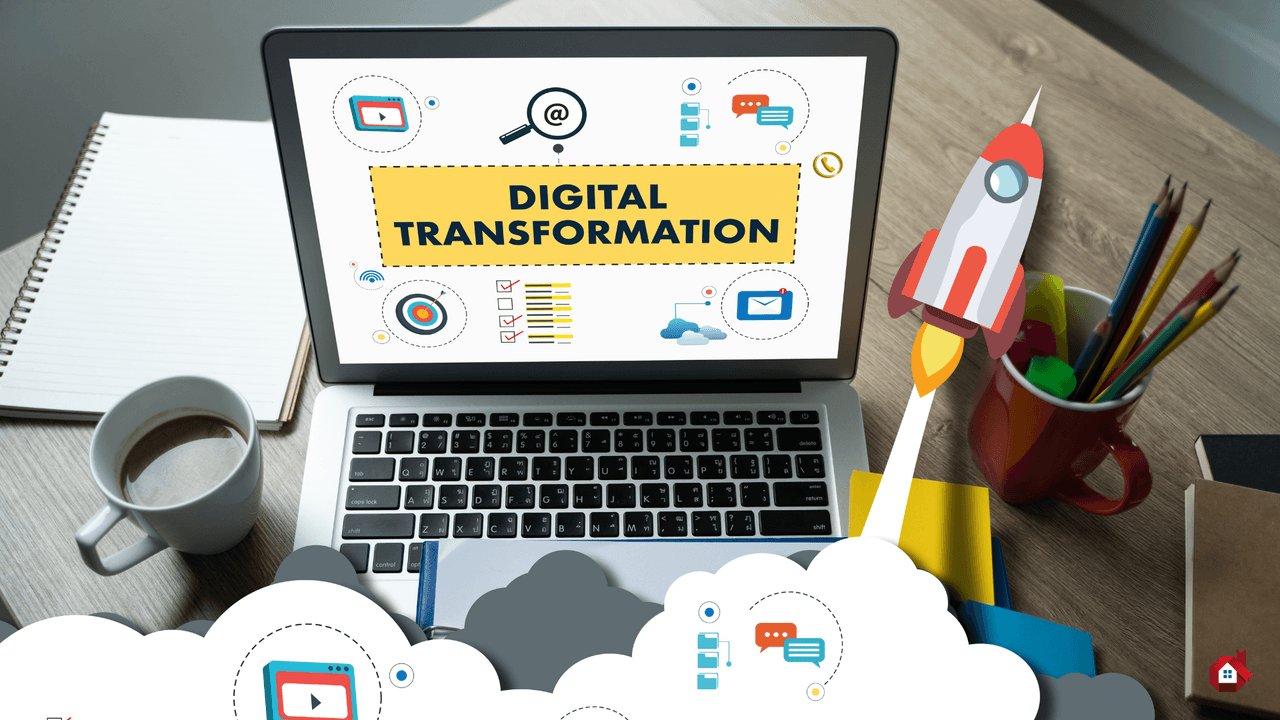How to Effectively Plan a Digital Transformation in the Construction Industry
By Editorial Team
Updated on August 13, 2025

In a world that’s constantly evolving, digital transformation has become a massive strategic issue for companies. It’s a process that involves digital technologies throughout all organization divisions. This approach necessitates business process restructuring, a cultural change, and optimal information integration. Learn how to plan and execute flawlessly a digital transformation, the goals behind such a venture, and current trends.
Digital Transformation: What Does It Mean for a Construction Company?

To execute a digital transformation, you can lean on the following:
Management software
Building information modeling (BIM)
Artificial intelligence (AI)
Working with management software allows you to digitize your projects to consolidate all data and render it accessible to all stakeholders. As such, it ensures effective communication channels between worksites and corporate offices, with real-time control over all stages of the construction process.
Mastering building information modeling (BIM) means working with digital mockups and digital twins to simulate activities within the building in question. That way, any interference between trade work is detected.
Integrating AI not only digitizes processes and analyzes the digital development of a project but, above all else, processes all data to suggest solutions aimed at limiting delays and optimizing resources.
Yet, digital transformation in the construction industry isn’t limited to using the previously mentioned software. As we already detailed in another article, 3D concrete printing is a technology that allows for building residential property walls in under 24 hours. It represents a 95% gain, time-wise.
However, digital transformation comes at a cost.
Easily find clients starting today
Get started today and connect with the projects that suit you best!
What are digital transformation goals to consider?
Growth
Adapting and streamlining in the face of competition
Improving operational efficiency
Increasing productivity
Promoting worksite and corporate office collaboration and communication
Increasing customer satisfaction
All these roads lead to the most important: the competitive factor throughout.
What are the 3 pillars of a digital transformation?

Digital Strategy
There is more than just one digital strategy to establish. The reality of the matter is that every business must analyze its functioning accurately and choose one or more of the following solutions:
BIM
AI
Management software
Virtual or augmented reality
Drones and other robots
How to Implement BIM in a Business

BIM can be implemented by knowing precisely what each and every company employee does, day-to-day. In real-time use, everyone is "digitized" based on the functions they carry out.
BIM works in steps, such as:
Planning
Execution
Building
To map out the processes, you need to have a certain level of standardization. Implementing BIM successfully means assigning one person within the realm of the company to do it. Albeit, keep in mind that implementing BIM requires roughly three years of work. Why? Because you have to match the assimilation pace unique to the business ecosystem that’s already established.
To do so under the best possible conditions, you need to have an internal roadmap that’s an extension of the government’s roadmap.
BIM will then become the way to do things; a way of working that may narrow down processes from a two-month timeline to a two-week delay. Any sort of feedback related to experiences allows, for example, to state that there will be fewer errors regarding:
Equipment safety
Service deployment
BIM allows for limiting conflicts that weren’t spotted beforehand, in ventilation ducts, for example. As such, there are fewer errors and do-overs, which means fewer material losses. Therefore, one in two companies that have started using BIM have noticed the following:
Costs are cut in two (50% lower)
Project timelines are 50% faster
Once implemented, BIM ensures the following:
Less paperwork
More control
Enhanced simplicity
While the upfront investment might seem like a lot, long term, the return on such a venture is much greater. The goal is for BIM to be used throughout the industry. Neglecting to do so would be equivalent to, in time, extracting your company from the business ecosystem, and thus distancing yourself increasingly from construction projects. BIM does, without a doubt, increase the amount of time spent in the office, preparing the construction worksite, but this time is well-spent and later recouped when it comes to project execution.
Evolution Process
Regarding the digitization deployed throughout the construction industry, the McKinsey study done in Quebec in 2015, proved that the industry in question is barely more digitized than the agricultural sector.
Therefore, a progressive transformation is mandatory to face challenges down the line:
Labour shortage
Sustainable development
National and international competition
As such, BIM is intended for mastering a lot of information at once during a construction project, to process it faster and with greater ease.
Prior to fully implementing building information modeling, you can very well implement much simpler changes. For example, the use of mobile technologies, which groups smartphones, tablets, or laptops, can be paired with recording and automated data-processing devices.
As for worksite-used AI, it helps improve three key areas:
Safety
Efficiency
Accuracy
Once used company-wide, AI is an integral component in designing construction blueprints and building infrastructures. Down the line, the evolution process of construction company digitization promises MEPF system improvements, which stands for mechanical, electrical, plumbing, and fire protection. With AI, the possibility of including water and power lines, as well as air conditioning ducts, will be feasible, while bypassing any issues relating to other stages of the construction process.
Skills and Innovations
Developing BIM software for business purposes and remaining open-minded with AI-led solutions results in further awareness when it comes to training future employees. As such, cutting-edge practices are currently being deployed in training and educational services.
Training programs dedicated to implementing BIM software within companies are offered already by several colleges, such as the Cégep du Vieux Montréal and Cégep Limoilou.
Innovation-wise, digital transformation and the emergence of artificial intelligence in the construction industry are often seen as risks in terms of job security. However, the truth of the matter is that the goal behind digital transformation in the industry is to replace mundane and redundant tasks that have very little added value.
In other words, artificial intelligence would bring labourers back to the heart of the trade in question, that of construction work.
Tech Tools Benefiting the Construction Industry

Companies operating within the construction industry mainly focused their efforts on acquiring cutting-edge materials, such as the following:
Virtual or augmented reality
Robotization
Virtual and Augmented Reality
Virtual reality is used during all steps of a construction project. At first, it’s used to create and swiftly visualize, at any given time, the project’s design. As such, it serves both the company and the customer. In the end, VR is used to assist construction teams during the actual building phase of the project.
Therefore, virtual reality is used in conjunction to achieve the following project outcomes:
Improving design comprehension
Improving buildability
Limiting suspended or postponed work
Visiting the worksite virtually and recurringly
Augmented reality adds an additional dose of realism. How? By combining virtual reality with remote presence. Meaning augmented reality combines the real world with a virtual one.
In other words, you're on a future project work site. Construction hasn’t even started yet; it’s bare land. With augmented reality, you can already see the transformation’s impact. Your project is virtually deployed on-site courtesy of digital work that adds virtual objects or buildings. Naturally, this all takes place inside a VR headset.
Virtual reality is also making headway in training the next generation of construction workers. As such, the National Electric Trade Council (NETCO), was granted 4.5 million dollars in funding to develop virtual electricity-related training.
The Use of Robots on Construction Worksites
Robots are mainly used on worksites for the following purposes:
Carry out repetitive tasks
Lift heavy loads
Provide a bird’s-eye view
Maneuver with accuracy in restricted spaces
We have an entire article detailing the presence of robots on worksites. Here's a rundown of a few mentioned:
Data-collecting robotic dogs
Brick-laying or masonry robots
Demolition or drilling robots
3D printers
Others
There are dozens, capable of carrying out all your worksite-related needs. But, this is where you need to tread carefully. Robots aren’t cheap, and they might not come in handy as often as you'd like.
The use of such an investment will depend on recurring needs for similar worksites throughout a work year. In other words, when it comes to digital transformation, assess your needs and set yourself some goals before purchasing expensive equipment to measure up to competitors.
The Different Software

Earlier in the article, we mentioned several different management software that were a vital component of a digital transition. Among these, one finds the following software:
Project management
Human resources
Payroll
Others
You could even add a content management system (CMS), in-house communication tools (Slack, Microsoft Teams, Lark, etc.), and company websites or platforms. Basically, everything that could streamline and simplify your pathway to meeting goals, customer management, material purchases, or your company’s trajectory.
In this realm, the Procore software is the perfect example. It’s compatible with both computers and mobile devices, and allows for the following actions:
Issue or respond to RFPs
Design 2D and 3D plans
Draw up quotes, contracts, timelines, etc.
Compare budgets, income statements, etc.
Provide estimates
Create charts
Highlight standards and regulations (150 countries)
And more
The above-listed features are solely what Procore can do in the pre-project stage. After said stage, the software can also do the following:
Update all documents in real-time (emails, daily logs, etc.)
Standardize processes between all parties involved
Manage expenses
Productivity overview
Should it remind you of BIM software benefits, it’s simply because Procore can help guide your digital transformation toward this type of management and organization.
If we wanted to focus solely on a digital transformation that targeted construction sites specifically, we would have mentioned the following software: Fusion 360, OpenSpace.ai, PlanSwift, and most especially, ConstructN.ai.
The latter allows you to wander throughout a construction worksite when connected to a 360° camera. It tracks the work and links the progression directly to the calendar, enabling those involved to stay on track while working on-site. And it doesn’t end here, this software can also calculate the differences between the plan and the construction itself, in real time.
What are the construction stakes and challenges in Quebec in a digital era?

The stake is clear: remain competitive.
In Ottawa, the government dished out 40 million dollars toward artificial intelligence for the construction industry alone. In Quebec, 700 million dollars were invested into AI by the government between 2017 and 2023.
As of today, 45,000 AI professionals are from Quebec, and of those, 2,200 are considered highly specialized. So much so that, today, having bypassed 5% of companies using AI, the province of Quebec is considered the most advanced in the country.
Now, the primary hurdle is to train more BIM software and AI specialists to lead digital transformations for as many organizations as possible. From retail to construction, by way of mobile devices and online shopping platforms, the innovation-centric culture must extend to all sectors.
Which is what led to the development of ICQ 4.0.
The IQC 4.0: A Digital Transition’s Key Player
Why IQC 4.0? (Initiative Québécoise pour la construction—Quebec-based construction initiative) The construction industry is facing a massive hurdle for every construction project undertaken: managing incoming information from all parties involved. By management, what’s meant above all is that necessary information is communicated to every party involved with the project.
Digitizing all information not only allows for real-time, or nearly so, decision-making but also for certain computerized decisions. To do so, IQC 4.0 relies on several different technologies:
Automation (task automation or cobots)
Drones
RFID tags
3D printing
Artificial intelligence
Augmented materials
Predictive monitoring tools
Virtual reality
3D laser scanning
Exoskeletons
Mobile technology (smartphones, tablets, etc.)
Parties involved with the construction industry have also witnessed the McKinsey study and laid eyes on reports from both Atkins and KPMG. What have they come to understand? In a few year’s time, business opportunities from public actors will always consider the following three components:
Total cost
Sustainability
Ecology
To maintain its competitive edge, the industry must transition toward a digital transformation, so much so that IQC 4.0 is hoping for a “large-scale building information modeling deployment.”
The situation is rather clear-cut:
Increase performances, industry-wide
Increase productivity
Sustain its business model
Improve competitivity
Digital Transformation: To Innovate Is to Prosper
A well-executed digital transformation requires a strategic approach, one that is implemented in anticipation of future trends. This entails choosing reliable technologies and using digital solutions that improve operational efficiency and customer experience. Moreover, communication transparency, and all-around stakeholder involvement, guarantee a widespread system adoption and limit aversion to change. By implementing these strategies, businesses can helm the waters of a never-ending global evolution. Therefore, a digital transformation may not solely be a trend, but a worthwhile strategy to remain significant and prosper in today’s global economy.
Looking for something else?
Related articles
The latest industry news, interviews, technologies, and resources.

Léa Plourde-Archer
•15 Aug 2025
Entrepreneurial life is not easy. Depending on the season, it can be difficult to get renovation contracts, even if you meet with a lot of potential clients. You may have the necessary experience and skills, but people are simply not calling back.

Editorial Team
•26 Aug 2025
It’s not much of a secret that the construction industry is facing a labour shortage, as many companies report a lack of labour although faced with growing demands. With the industry itself booming in sectors such as residential housing, commercial properties, and public work projects, the workforce necessary to take on these projects isn’t readily available. So, what effect will the labour shortage have?

Amanda Harvey
•31 Mar 2025
Unanticipated noises in the wrong place at the wrong time can be jarring, stressful, and annoying. The best way to deal with it is soundproofing at the source.

Cynthia Pigeon
•03 Nov 2025
Are your living room windows looking a little drab for your liking? Lucky for you, the various models available on the market are as ample as they are diverse! Should you be struggling to find the perfect model for your living room, check out the following models that are sure to help you make up your mind, regret-free.

Editorial Team
•07 Nov 2023
Renovating a kitchen can be expensive, and depending on the changes made, your budget can quickly increase. Of course, you don’t have to tear down your cabinets or demolish a wall in order to tastefully renovate and offer your kitchen a new look.